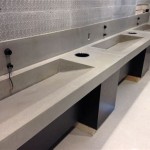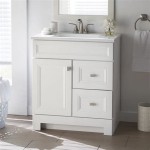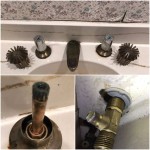Can You Put Drano In Bathroom Sink? An In-Depth Examination
The question of whether Drano can be used in a bathroom sink is a common one, arising from the frequent occurrence of clogs in this particular plumbing fixture. Bathroom sinks are susceptible to blockages caused by various substances, including hair, soap scum, toothpaste residue, and small objects. Drano, a commercially available drain cleaner, is often considered a quick and easy solution for resolving these clogs. However, the decision to use Drano in a bathroom sink requires careful consideration due to its chemical composition and potential consequences for plumbing systems and personal safety.
Drano products typically contain a combination of chemicals designed to dissolve or break down organic matter that commonly contributes to drain clogs. These chemicals often include sodium hydroxide (lye) and sodium hypochlorite (bleach), which work synergistically to saponify fats, dissolve proteins, and oxidize other organic materials. Some formulations may also contain aluminum particles, which react with sodium hydroxide to generate heat and further enhance the dissolving process. The high alkalinity and reactivity of these chemicals are what make Drano effective at clearing clogs, but also contribute to its potential hazards.
Before using Drano in a bathroom sink, it is crucial to understand the potential ramifications for the plumbing system. The corrosive nature of Drano can damage pipes, particularly older plumbing made of materials like PVC or metal. Repeated use of Drano can weaken pipe joints, leading to leaks or even pipe failure. Furthermore, the heat generated by the chemical reaction can soften PVC pipes, making them more susceptible to deformation and damage. The consequences of plumbing damage can be costly, requiring repairs or even replacement of entire sections of the plumbing system.
In addition to the potential damage to plumbing, Drano poses significant risks to human health. The chemicals in Drano are highly corrosive and can cause severe burns to skin and eyes upon contact. Inhalation of Drano fumes can irritate the respiratory system, leading to coughing, wheezing, and difficulty breathing. Ingestion of Drano is extremely dangerous and can cause severe internal burns, potentially leading to death. It is imperative to handle Drano with extreme caution, wearing appropriate protective gear such as gloves and eye protection, and ensuring adequate ventilation.
Furthermore, the mixing of Drano with other cleaning products can create hazardous chemical reactions. For example, mixing Drano with acidic drain cleaners can produce toxic chlorine gas, which can cause severe respiratory irritation and even death. It is crucial to avoid mixing Drano with any other chemicals and to follow the manufacturer's instructions carefully.
Understanding Drano's Chemical Action
Drano's effectiveness stems from its powerful chemical action. The primary active ingredients, sodium hydroxide (NaOH) and sodium hypochlorite (NaClO), work in concert to degrade the organic materials that typically cause clogs. Sodium hydroxide, also known as lye, is a strong base that reacts with fats and grease through a process called saponification. This process converts the fats into soap, which is water-soluble and can be flushed away. Sodium hypochlorite, or bleach, acts as an oxidizer, breaking down proteins and other organic matter into smaller, more manageable molecules.
The combination of saponification and oxidation is highly effective at dissolving hair, soap scum, and other common clog-causing substances. However, this chemical action is indiscriminate, meaning it can also affect other materials it comes into contact with. This is why Drano can damage pipes and cause burns to skin and eyes.
Some Drano formulations also contain aluminum particles. When these particles come into contact with sodium hydroxide, they react to produce hydrogen gas and heat. The heat further accelerates the chemical reactions, while the hydrogen gas can create pressure within the drainpipe, potentially dislodging the clog. However, this reaction also adds to the risk of pipe damage, especially in older or weakened plumbing systems.
Evaluating the Risks to Plumbing Systems
The risks associated with using Drano on plumbing systems should not be underestimated. The corrosive nature of the chemicals can erode and weaken pipes over time, particularly those made of older or less resistant materials. PVC pipes, commonly used in modern plumbing, can be softened and deformed by the heat generated by Drano. Metal pipes, such as those made of copper or iron, can corrode and develop leaks due to the high alkalinity of Drano.
Repeated use of Drano can exacerbate these problems, leading to more significant damage and costly repairs. The chemical reaction can also damage the seals and joints between pipes, leading to leaks. In severe cases, the entire plumbing system may need to be replaced. Before using Drano, the type and condition of the plumbing should be considered. Older plumbing systems are more vulnerable to damage and may not be able to withstand the harsh chemical action of Drano.
Furthermore, the buildup of partially dissolved clog material can contribute to the problem. Drano may not completely dissolve all of the clog material, leaving behind a residue that can solidify and further restrict the flow of water. This can necessitate more frequent use of Drano, creating a cycle of chemical damage and recurring clogs.
Exploring Safer Alternatives to Drano
Given the potential risks associated with using Drano, it is prudent to explore safer and more environmentally friendly alternatives for unclogging bathroom sinks. Several methods are available that can effectively remove clogs without the use of harsh chemicals.
One of the simplest and most effective methods is to use a plunger. A plunger creates suction that can dislodge clogs and allow them to be flushed away. To use a plunger effectively, the sink should be partially filled with water to create a tight seal around the drain opening. The plunger should then be vigorously pumped up and down for several minutes. This method is particularly effective for clogs caused by hair and soap scum.
Another effective method is to use a drain snake, also known as an auger. A drain snake is a flexible tool that can be inserted into the drainpipe to break up or retrieve clogs. This method is particularly useful for clogs that are located deeper within the drainpipe. Different types of drain snakes are available, ranging from small hand-cranked models to larger motorized versions.
A mixture of baking soda and vinegar can also be used to unclog drains. Pouring one cup of baking soda followed by one cup of vinegar into the drain creates a chemical reaction that can help to dissolve clogs. After allowing the mixture to sit for about 30 minutes, flush the drain with hot water. This method is less harsh than Drano and is generally safe for use on most plumbing systems.
Boiling water can also be effective for dissolving clogs caused by grease and soap scum. Carefully pour a pot of boiling water down the drain, taking care to avoid splashing. This method is not recommended for PVC pipes, as the high temperature can damage the plastic.
Preventative measures can also help to reduce the frequency of clogs. Using drain screens to catch hair and other debris can prevent these materials from entering the drainpipe. Regularly flushing the drain with hot water can also help to prevent the buildup of soap scum and other residues.
Enzymatic drain cleaners are also a safer alternative to Drano. These cleaners contain enzymes that break down organic matter without damaging pipes. While they may take longer to work than Drano, they are a gentler and more environmentally friendly option.
In conclusion, while Drano may seem like a convenient solution for unclogging bathroom sinks, the potential risks to plumbing systems and human health should be carefully considered. Safer alternatives, such as plungers, drain snakes, baking soda and vinegar, and boiling water, are often just as effective and pose less risk. By taking preventative measures and using safer methods, it is possible to maintain clear and functional drains without resorting to harsh chemicals like Drano.

Drano Max Gel

Does Drano Work How It Review Prudent Reviews

Why Plumbers Drano What Homeowners Should Know Metro Heating Cooling

Does Drano Work How It Should I Use Smiley Drain Cleaning

How To Clear A Clogged Drain Reviews By Wirecutter

Drano Max Gel Clog Remover Target

Liquid Plumr Vs Drano Which Drain Cleaner Is Better Prudent Reviews

Drano 60 Oz Commercial Line Max Build Up Remover 333671 The Home Depot

Drano Not Working How To Remove Clogs When Fails Prudent Reviews

The Best Diy Homemade Drano Recipe
Related Posts







